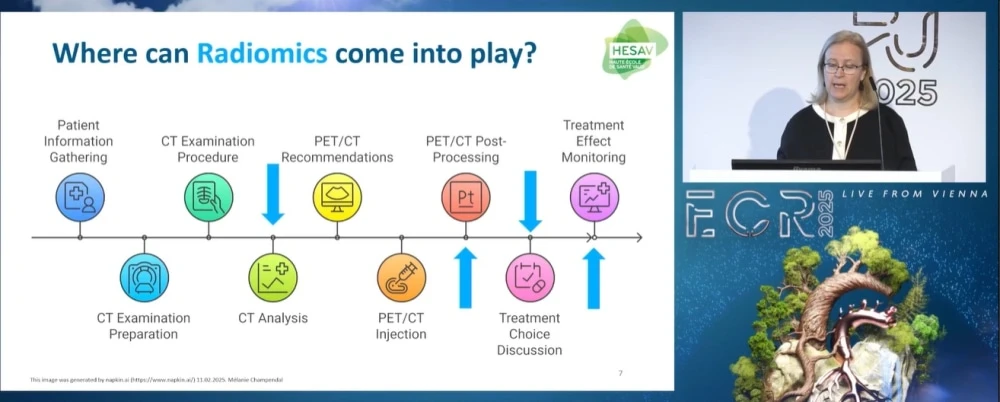The session onnuclear medicineat the European Congress of Radiology showcased cutting-edge advancements in AI, radiomics, emerging imaging technologies and radioprotection. Experts highlighted how these innovations are transforming diagnostics, treatment precision and safety in nuclear medicine.
AI and Radiomics: Transforming Nuclear Medicine
Mélanie Champendal (Lausanne, Switzerland) explored the integration of AI and radiomics in nuclear medicine, highlighting their distinct methodologies and applications. AI employs neural networks and database learning, analysing diverse datasets including patient records, genomics and imaging, while radiomics focuses solely on imaging data, extracting mathematically derived features based on shape, intensity and texture.
She demonstrated AI’s ability to reduce radiation doses while improving image quality and sustainability. "AI can step in every step of the stage and of the procedures… in the choice of the treatment and in the monitoring of the effect of the treatment," she noted.
Radiomics is particularly valuable in tumour characterisation, predicting treatment responses and stratifying patient risk. By combining AI-driven automation with radiomics’ detailed imaging analysis, nuclear medicine can achieve greater precision and efficiency, ultimately improving patient outcomes.
Emerging Technologies and Theranostics in Nuclear Medicine
Christina Baun from Odense, Denmark, discussed how emerging technologies and diagnostics are transforming nuclear medicine. She highlighted the shift towards hybrid imaging, with PET/CT and PET/MRI replacing conventional gamma cameras, enhancing diagnostic precision. Digital PET scanners, using silicon photomultipliers, improve spatial resolution, timing and sensitivity, allowing for better detection of small lesions, particularly in cancer and neurology. According to her, "Digital PET significantly improves the visualisation of small malignant lesions in the lung and subpleural areas."
She also covered advancements in SPECT imaging, including solid-state detectors and multi-pinhole collimators, enhancing resolution and patient-specific adaptation. Another key focus was theranostics, combining diagnostics and therapy for personalised cancer treatment. She explained that this approach ensures that “only patients with a positive target expression will be selected for the following treatment."
Baun emphasised the growing importance of hybrid imaging and the need for continuous education in nuclear medicine to keep pace with rapid technological advancements.
Radioprotection Innovations in Nuclear Medicine
Daniela Fonseca Ribeiro, from King’s College Hospital, discussed innovations in radiation protection, stressing its importance for patients, carers, and healthcare professionals. She highlighted the principles of justification, optimisation and limitation, stating, "We need to keep the doses as low as reasonably achievable."
She outlined key strategies like minimising exposure time, increasing distance and using shielding. Advances in imaging, including AI-driven optimisation, were also discussed.
Regarding theranostics, Ribeiro explained that administering amino acids can significantly reduce radiation exposure to the kidneys, with studies showing a decrease of around 45%. She also covered safety guidelines for patients and carers.
She introduced emerging molecular therapies, such as phosphorus-32 microparticles for pancreatic tumours and rhenium resin for skin cancer, stressing the need for specialised shielding, waste management and staff training.
Ribeiro concluded by reinforcing the importance of innovation and strict safety protocols in radiation-based therapies.
The field of nuclear medicine is undergoing a transformation due to advancements in artificial intelligence, hybrid imaging methodologies, theranostics and radioprotection strategies. As these technologies progress, the integration of these innovations will be essential for improving diagnostic precision, tailoring treatment regimens to individual patient profiles and enhancing the safety protocols for both patients and healthcare personnel.
Source & Image Credit: ECR 2025










